Litóhoro, Pieria, Greece, Saturday morning, 9 September 2000
We landed in Athens Monday morning after a four-hour flight, at 4:30 a.m. local time. We watched dawn break over Attica from the rather smoky airport waiting lounge, where we sat killing time for a few hours, awaiting such time as we could at least deposit our small mountain of luggage at our hotel. During our overpriced ride into Athens I noticed posters advertising productions of both The Clouds of Aristophanes and The Persians of Aeschylus. We deposited our luggage in a hotel lobby rich with marble (which would appear to be cheaper than wood in this country and is lavishly used for flooring, paneling, and almost all stairs). Then we set out on foot for breakfast, which we bought from a nearby bakery and ate on a bench outside. Fortunately, the triple room for the children came available around ten, and our own double an hour or two later, so we were all showered and sacked out by noon. It was hot, but with shutters closed and ceiling fans on we all managed to sleep till dinner time, thus at least beginning to make up for our missed night's sleep.
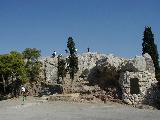
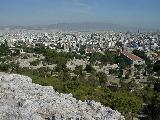 The next morning we opted to tour the Acropolis, and got a taxi to the foot of the path there for the equivalent (with tip) of $1.35. When the children spied the Areopagus (left) just off to the side of the upward path, they immediately wanted to climb it. This is the "Mars hill" where Paul preached to the Athenians (Acts 17.16-34, quoted in the original Koinê Greek on a bronze plaque that appears as a dark rectangle towards the right in the photo). It is also the site where the goddess Athene founded the court that for its first case heard Furies v. Orestes (a case of matricide, with Apollo Esq. for the defense, dramatized by Aeschylus in The Eumenides.) The stairs up the side and much of the rock on top were highly polished and extraordinarily slippery under our sandals, simply because of all the feet that had trod this very special ground. From the top there are wide prospects of Athens including that at right, showing the ancient Agora or marketplace, with the well-preserved Doric temple of Hephaestus at left and the reconstructed Stoa of Attalus on the right (the long building seen almost end-on). The Agora was the original venue for both the meetings of the assembly and the annual Great Dionysia festival that gave birth to the tragic drama, though both of these civic activities shifted later to their own dedicated spaces: the hill of Pnyx and the Great Theater of Dionysus, respectively.
The next morning we opted to tour the Acropolis, and got a taxi to the foot of the path there for the equivalent (with tip) of $1.35. When the children spied the Areopagus (left) just off to the side of the upward path, they immediately wanted to climb it. This is the "Mars hill" where Paul preached to the Athenians (Acts 17.16-34, quoted in the original Koinê Greek on a bronze plaque that appears as a dark rectangle towards the right in the photo). It is also the site where the goddess Athene founded the court that for its first case heard Furies v. Orestes (a case of matricide, with Apollo Esq. for the defense, dramatized by Aeschylus in The Eumenides.) The stairs up the side and much of the rock on top were highly polished and extraordinarily slippery under our sandals, simply because of all the feet that had trod this very special ground. From the top there are wide prospects of Athens including that at right, showing the ancient Agora or marketplace, with the well-preserved Doric temple of Hephaestus at left and the reconstructed Stoa of Attalus on the right (the long building seen almost end-on). The Agora was the original venue for both the meetings of the assembly and the annual Great Dionysia festival that gave birth to the tragic drama, though both of these civic activities shifted later to their own dedicated spaces: the hill of Pnyx and the Great Theater of Dionysus, respectively.
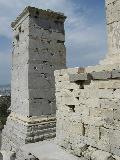
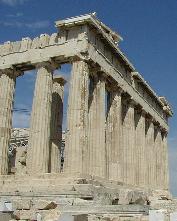
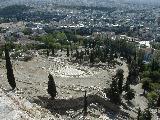 Then it was up on up the path to the Acropolis itself, with Stas and me both thinking back thirteen years to our first visit, shortly before we committed ourselves to making this family together, with these children now walking in front of us (with that brilliant Greek sun in their hair), seeing it all for the first time. The great square pillar fronting the Propylaia (which itself fronts the Acropolis) particularly caught my eye with its wonderful color and texture and touch of vegetation (far left). The Parthenon itself is enduring a protracted reconstruction; and while I can sympathize with the aim--and do not, like some romantics, positively prefer the old ruined silhouette with the whole middle blasted out by a seventeenth-century explosion--still there is no denying that the scaffolding outside and the great crane here visible inside are both jarringly ugly. On the other hand, hearing the clinking of chisels on marble, as bits and pieces were fashioned by hand in an adjacent shed, positively added to the experience of the place. From just outside the Parthenon one can look down over the parapet for a bird's-eye or goddess's-eye view of the Great Theater of Dionysus (right).
Then it was up on up the path to the Acropolis itself, with Stas and me both thinking back thirteen years to our first visit, shortly before we committed ourselves to making this family together, with these children now walking in front of us (with that brilliant Greek sun in their hair), seeing it all for the first time. The great square pillar fronting the Propylaia (which itself fronts the Acropolis) particularly caught my eye with its wonderful color and texture and touch of vegetation (far left). The Parthenon itself is enduring a protracted reconstruction; and while I can sympathize with the aim--and do not, like some romantics, positively prefer the old ruined silhouette with the whole middle blasted out by a seventeenth-century explosion--still there is no denying that the scaffolding outside and the great crane here visible inside are both jarringly ugly. On the other hand, hearing the clinking of chisels on marble, as bits and pieces were fashioned by hand in an adjacent shed, positively added to the experience of the place. From just outside the Parthenon one can look down over the parapet for a bird's-eye or goddess's-eye view of the Great Theater of Dionysus (right).

 In the Acropolis Museum we saw this famous and moving little grave stele known as the contemplative or mourning Athena, and a surprisingly large amount of material from the earlier Parthenon, the one the Persians wrecked when the Athenians had strategically retreated to the shelter of their "wooden walls" (i.e., their navy, with which a little later they defeated the invaders at Salamis). The statuary group in one of the pediments depicted the gigantomachy, the Olympian gods' victorious battle for supremacy in heaven; and this restored figure of Athena from that group vividly shows, in her snake-fringed shawl or cape, the traces of another and similar religious conflict, in which the Olympian religion partly demonized and partly appropriated an older chthonic religion and its signifiers.
In the Acropolis Museum we saw this famous and moving little grave stele known as the contemplative or mourning Athena, and a surprisingly large amount of material from the earlier Parthenon, the one the Persians wrecked when the Athenians had strategically retreated to the shelter of their "wooden walls" (i.e., their navy, with which a little later they defeated the invaders at Salamis). The statuary group in one of the pediments depicted the gigantomachy, the Olympian gods' victorious battle for supremacy in heaven; and this restored figure of Athena from that group vividly shows, in her snake-fringed shawl or cape, the traces of another and similar religious conflict, in which the Olympian religion partly demonized and partly appropriated an older chthonic religion and its signifiers.
The next day, Wednesday, we combined business with a little sightseeing. After hitting an internet cafe on Syngrou Avenue to check e-mail, we continued on foot past Hadrian's Arch, the Temple of Zeus, and the Záppion, and through the botanic gardens to the Benáki museum, which we had attempted but found closed the afternoon before. Though there are some ancient artifacts on display there, that part of the collection cannot hope to rival either the National Archaeological Museum in Athens or the British Museum; the chief interest and glory of the place lies in its collection of artifacts from the full range of Greek history from the Byzantine period to the present. We lunched at the museum cafe, a beautiful and elegant outdoor setting with lots of marble and potted plants and big wood-and-white-canvas parasols, several storeys above the noise of the Athenian street. Here again I was deeply moved to see our children bathed in the brilliant sunlight of Greece, the same unique sunlight that the ancient Greek poets so often equated with life itself. After lunch we proceeded on foot much farther than expected to the U.S. embassy, where after passing through heavy security and paying an inordinate amount of money I got an insurance form notarized (pertaining to our car accident of 15 August). From there we took an electric trolley to Omónia Square, where we got Trevor new sneakers, and another back to our hotel's neighborhood, where we made arrangements for the morrow's trip up here to Litóhoro.
Thursday morning we got up before six and boarded two taxis at seven for the Lárisa train station. The train bore us past the sacred mountains of Helicon and Parnassus, and through and among a lot more mountains as well, some of which had been burned in the summer's fires. Then it bore us down the valley of the river Peneos, where Goethe set one of the acts of Part II of his Faust, to the shore of the blue Aegean. After six somewhat smoky hours on the train we emerged at Litóhoro's seaside station, which is newly built and not yet staffed or provided with any amenities, even a working phone. Such taxis as appeared were all reserved for others, but the driver of one phoned a colleague, who in two trips brought us and our luggage where we needed to go. I came alone with the first load, and though the driver took no money I was convinced from his evident and voluble disgust at being roped into this business that he had no intention of picking up the others. Fortunately I was mistaken in this, and he reappeared with the rest of the family and luggage, after I had desperately and finally successfully tried to get in touch with our landlord by phone, with the help of the hôtelier of the nearby Villa Drosos Hotel. Indeed I had corralled the landlord into driving me down to the station in his car, when a cell call informed him that my family had already been collected thence, and soon we spied the taxi itself on the road with us.

 That crisis past, we were utterly delighted with both the apartment and the town in which we found ourselves. The apartment is all white and very new and neat, and very well furnished even down to towels and pillows and sheets. A small balcony off the children's room gives a prospect of Mt. Olympus, as well as a yard covered with grape arbor and inhabited by numerous cats and chickens (left). A larger balcony opening off the living room and our bedroom gives a prospect to the sea three miles away (right), though unfortunately the open space it overlooks is strewn with litter. (Both balconies feature a nice touch of marble.) As for the town, it is very pretty and has so little motor traffic that pedestrians can saunter freely on all but one of the streets--and the one exception has plenty of sidewalk. The people all seem very friendly and welcoming and eager to help us, and an extraordinarily high proportion of them appear to be returned emigrants to the USA, and accordingly thoroughly fluent in English. Since our arrival we have been settling in, glad for the change from ten weeks' living out of suitcases, and glad too to be able to live for a while entirely without a car.
That crisis past, we were utterly delighted with both the apartment and the town in which we found ourselves. The apartment is all white and very new and neat, and very well furnished even down to towels and pillows and sheets. A small balcony off the children's room gives a prospect of Mt. Olympus, as well as a yard covered with grape arbor and inhabited by numerous cats and chickens (left). A larger balcony opening off the living room and our bedroom gives a prospect to the sea three miles away (right), though unfortunately the open space it overlooks is strewn with litter. (Both balconies feature a nice touch of marble.) As for the town, it is very pretty and has so little motor traffic that pedestrians can saunter freely on all but one of the streets--and the one exception has plenty of sidewalk. The people all seem very friendly and welcoming and eager to help us, and an extraordinarily high proportion of them appear to be returned emigrants to the USA, and accordingly thoroughly fluent in English. Since our arrival we have been settling in, glad for the change from ten weeks' living out of suitcases, and glad too to be able to live for a while entirely without a car.
next entry
main/ToC page

 The next morning we opted to tour the Acropolis, and got a taxi to the foot of the path there for the equivalent (with tip) of $1.35. When the children spied the Areopagus (left) just off to the side of the upward path, they immediately wanted to climb it. This is the "Mars hill" where Paul preached to the Athenians (Acts 17.16-34, quoted in the original Koinê Greek on a bronze plaque that appears as a dark rectangle towards the right in the photo). It is also the site where the goddess Athene founded the court that for its first case heard Furies v. Orestes (a case of matricide, with Apollo Esq. for the defense, dramatized by Aeschylus in The Eumenides.) The stairs up the side and much of the rock on top were highly polished and extraordinarily slippery under our sandals, simply because of all the feet that had trod this very special ground. From the top there are wide prospects of Athens including that at right, showing the ancient Agora or marketplace, with the well-preserved Doric temple of Hephaestus at left and the reconstructed Stoa of Attalus on the right (the long building seen almost end-on). The Agora was the original venue for both the meetings of the assembly and the annual Great Dionysia festival that gave birth to the tragic drama, though both of these civic activities shifted later to their own dedicated spaces: the hill of Pnyx and the Great Theater of Dionysus, respectively.
The next morning we opted to tour the Acropolis, and got a taxi to the foot of the path there for the equivalent (with tip) of $1.35. When the children spied the Areopagus (left) just off to the side of the upward path, they immediately wanted to climb it. This is the "Mars hill" where Paul preached to the Athenians (Acts 17.16-34, quoted in the original Koinê Greek on a bronze plaque that appears as a dark rectangle towards the right in the photo). It is also the site where the goddess Athene founded the court that for its first case heard Furies v. Orestes (a case of matricide, with Apollo Esq. for the defense, dramatized by Aeschylus in The Eumenides.) The stairs up the side and much of the rock on top were highly polished and extraordinarily slippery under our sandals, simply because of all the feet that had trod this very special ground. From the top there are wide prospects of Athens including that at right, showing the ancient Agora or marketplace, with the well-preserved Doric temple of Hephaestus at left and the reconstructed Stoa of Attalus on the right (the long building seen almost end-on). The Agora was the original venue for both the meetings of the assembly and the annual Great Dionysia festival that gave birth to the tragic drama, though both of these civic activities shifted later to their own dedicated spaces: the hill of Pnyx and the Great Theater of Dionysus, respectively.






